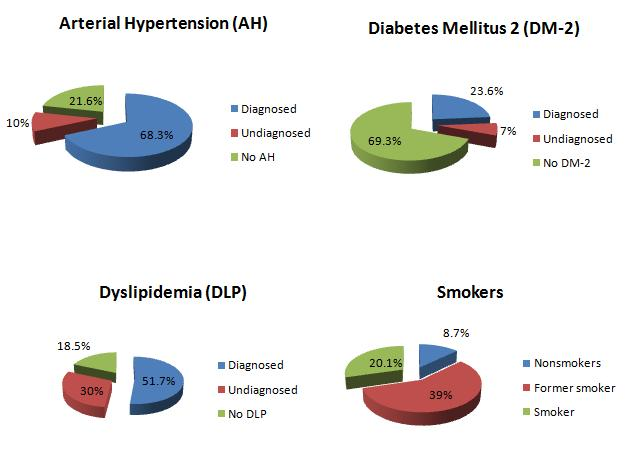Session Information
Date: Sunday, November 13, 2016
Title: Metabolic and Crystal Arthropathies - Poster I: Clinical Practice
Session Type: ACR Poster Session A
Session Time: 9:00AM-11:00AM
Background/Purpose:
Gout is a disease triggered by the crystallization of uric acid in the joints secondary to persistent hyperuricemia, that leads to chronic inflammation. Patients with gout frequently have comorbidities including cardiovascular (CV) disease, kidney failure, diabetes mellitus etc. In fact, some these can increase the levels of uric acid and contribute to develop gout, and also deteriorate the CV profile of these patients. The aim of the present study was to assess the prevalence of unknown cardiovascular risk factors (CVRF) in patients with gout.
Methods : Cross-sectional analysis of a inception cohort of gout patients recruited by consecutive sampling in our rheumatology unit. Gout was diagnosed by visualization of monosodium urate crystals in synovial fluid or tophus sample. A structured CV assessment included CVRF, measurement of blood pressure, anthropometry and lab tests. Arterial Hypertension (AH) was defined by previous diagnosis, blood pressure ≥140/90mmHg and/or use of antihypertensive agents. Type 2 Diabetes Mellitus (DM-2) was defined by previous diagnosis, fasting blood glucose ≥126 mg/dL, glycosylated haemoglobin ≥6.5%; presence of microangiopathic complications was also registered. Dyslipidemia (DLP) was defined by previous diagnosis, use of hypolipidemic agents, or total cholesterol >200 mg/dL and/or triglycerides > 150 mg/dL. A descriptive analysis of the results is presented.
Results : The study involved 199 patients. The mean age was 63.4 (SD+/- 13.2) years, with 171 (85.9%) men. At inclusion the prevalence of CVRF was: AH in 136 patients (68.3%), DLP in 13 (51.8%), and DM-2 in 47 (23.6%). Seventy-six (38.6%) were found obese, smoking background was present in 40 (20.1%), use of diuretics (loop and/or thiazide) in 87 (43.7%), and chronic renal failure in 57 (28.6%). After structured assessment, the following undiagnosed CVRF were found: DLP in 59 patients (29.6%), AH in 20 (10.1%) and DM-2 in 14 (7%) [Figure]. New CVRF were found in 94 (46.7%) patients, among them 52 (26.1 %) had one CVRF, 13 (6.5%) had 2 CVRF, and even 3 CVRF were identified in 2 cases (1.0%).
Conclusion : Half of our patients showed at least one unknown CVRF, mostly DLP followed by hypertension and DM-2. This finding highlights the need for active screening for new CVRF in patients diagnosed with gout, due to the potential impact on the proper CV management. 
To cite this abstract in AMA style:
Ordoñez JC, Andres M, Sivera F, Carmona L, Vela P, Pascual E, Bernal JA. New Cardiovascular Risk Factors Screening in Patients with Gout [abstract]. Arthritis Rheumatol. 2016; 68 (suppl 10). https://acrabstracts.org/abstract/new-cardiovascular-risk-factors-screening-in-patients-with-gout/. Accessed .« Back to 2016 ACR/ARHP Annual Meeting
ACR Meeting Abstracts - https://acrabstracts.org/abstract/new-cardiovascular-risk-factors-screening-in-patients-with-gout/
